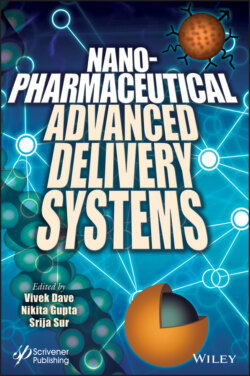Читать книгу Nanopharmaceutical Advanced Delivery Systems - Группа авторов - Страница 26
1.6 Characterization Techniques for Lipid Nanocarriers 1.6.1 Size and Morphology
ОглавлениеDuring parenteral administration, a significant factor in safety of biological systems is the particle size of the carrier system. Dynamic light scattering (DLS) is a method most often used for calculating particle size in solutions and conducting distribution-size study. Quasielastic light scattering or photon correlation spectroscopy (PCS) is the other term used instead of DLS. The method is based on Brownian movement of particle in dispersion. When laser light hits objects, it is scattered by Brown’s particle movement [91]. The motion of the particles depends on the size of the particle. The light intensity of laser light with a defined wavelength fluctuates the particles, which fluctuate the scattered light after striking with dispersed particles. By measuring the frequency of the scattered light fluctuation, the intensity of the Doppler shift can be determined by the use of a photon detector, depending on time and fluctuation. Fluctuations in light intensity are greatly affected by the viscosity of the solution and the temperature; hence, the particle size of dispersion can vary [91, 92–94].
Scanning electro-microscopy (SEM) and transmission electron microscopy (TEM) are the most needed tools to analyze morphological characteristics [95]. SEM and TEM characterization of nanoparticles provides shapes and surface facets, and it determines the accurate particle size of a particular particle in dispersion [96]. The morphological shape details can be taken from the SEM image for a large nanocrystal with a normal design. SEM works on the basis of scattered electrons and provides particulate morphology. The shape of a small nanocrystal cannot be analyzed by SEM because of its restricted resolution. Although TEM analysis is able to represent the morphology of such particles that are not suitable for SEM by passing electrons through in resultant, it differentiates the chemical entities on the basis of electron density [97].
Polarized light microscopy (PLM) is usually used to observed lyotropic liquid crystalline structures [98]. It can be used to confirm the presence of liposomes and similar structures in parenteral dispersion systems. The coordinated structure of the phospholipid surfaces results in anisotropical properties. Anisotropic systems deviate polarized light in the plane, which helps in imaging and gives a standard black and white or colored image using a λ-plate [98, 99].
SEM imaging only analyzes the samples in 2-D, that is, x- and y-axes, but cannot measure the z-axis to provide 3-D morphological information of a particle surface. Atomic force microscopy (AFM) overcomes this problem by analyzing the surface on the z-axis along with the x- and y-axes using deflection of a fine leaf spring. AFM is widely used for crystallinity studies of a sample. The technique uses fixed wavelengths to provide information on the molecular organization of crystals. In AFM imaging, with resolution up to 0.01 nm, the force between the surface of the material and the sensor tip is used [100]. Silicon wafers are usually used for sample fixation. The sample surface should be extra smooth for AFM imaging [101–106].
